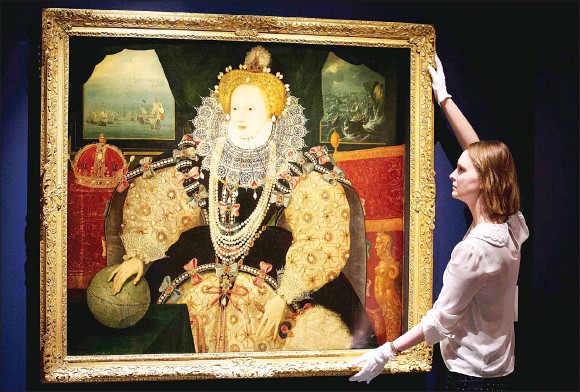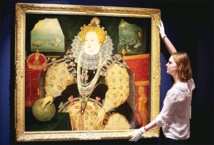Royal Museums Greenwich -- a group of four London museums -- bought the oil painting from the Tyrwhitt-Drake family in a private sale, Christie's auctioneers said, after £10.3 million ($13.6 million, 12.2 million euros) was raised.
The "Armada Portrait", painted around 1590 by an unknown artist, is the defining image of queen Elizabeth in her pomp.
It shows the monarch wearing a gold embroidered and jewelled dress with her hand resting on a globe, while the English fleet enjoys calm waters and the approaching Spanish fleet is wrecked in a storm.
Now part of the national collection, it will hang in the Queen's House, built in 1616 on the site of the original Greenwich Palace in southeast London, which was queen Elizabeth's birthplace.
£1.5 million for the painting came from more than 8,000 public donations raised since May, with the museum group putting up £400,000.
The Heritage Lottery Fund (HLF) gave £7.4 million raised through national lottery ticket sales, with the remaining £1 million coming from the Art Fund, a charity.
"The 'Armada Portrait' is a compelling historic icon, illustrating as it does a decisive conflict, inspiring female leadership, maritime power and the emergence of the Elizabethan 'Golden Age'," said HLF chairman Peter Luff.
"This image has shaped our understanding of 'Gloriana', the Virgin Queen, for over four hundred years and I am delighted that it will now have such an appropriate permanent home in Greenwich."
The painting was first recorded as being owned by the Drake family in 1775 and it is the first time it has been sold.
Drake conducted the second circumnavigation of the world in a single expedition between 1577 and 1580 and led the famous 1587 "Singeing of the King of Spain's Beard" raid on Cadiz.
A representative of the Tyrwhitt-Drake family said the painting had been "safeguarded for future generations" and could now be seen "in the context of our nation's great history".
Two other surviving versions of the painting exist: one at the National Portrait Gallery in London and the other at Woburn Abbey in Bedfordshire, southeast England, though the one connected to Drake is considered the most significant.
--------------------------------------------------------------------------------------------------
The "Armada Portrait", painted around 1590 by an unknown artist, is the defining image of queen Elizabeth in her pomp.
It shows the monarch wearing a gold embroidered and jewelled dress with her hand resting on a globe, while the English fleet enjoys calm waters and the approaching Spanish fleet is wrecked in a storm.
Now part of the national collection, it will hang in the Queen's House, built in 1616 on the site of the original Greenwich Palace in southeast London, which was queen Elizabeth's birthplace.
£1.5 million for the painting came from more than 8,000 public donations raised since May, with the museum group putting up £400,000.
The Heritage Lottery Fund (HLF) gave £7.4 million raised through national lottery ticket sales, with the remaining £1 million coming from the Art Fund, a charity.
"The 'Armada Portrait' is a compelling historic icon, illustrating as it does a decisive conflict, inspiring female leadership, maritime power and the emergence of the Elizabethan 'Golden Age'," said HLF chairman Peter Luff.
"This image has shaped our understanding of 'Gloriana', the Virgin Queen, for over four hundred years and I am delighted that it will now have such an appropriate permanent home in Greenwich."
The painting was first recorded as being owned by the Drake family in 1775 and it is the first time it has been sold.
Drake conducted the second circumnavigation of the world in a single expedition between 1577 and 1580 and led the famous 1587 "Singeing of the King of Spain's Beard" raid on Cadiz.
A representative of the Tyrwhitt-Drake family said the painting had been "safeguarded for future generations" and could now be seen "in the context of our nation's great history".
Two other surviving versions of the painting exist: one at the National Portrait Gallery in London and the other at Woburn Abbey in Bedfordshire, southeast England, though the one connected to Drake is considered the most significant.
--------------------------------------------------------------------------------------------------









 Home
Home Politics
Politics











